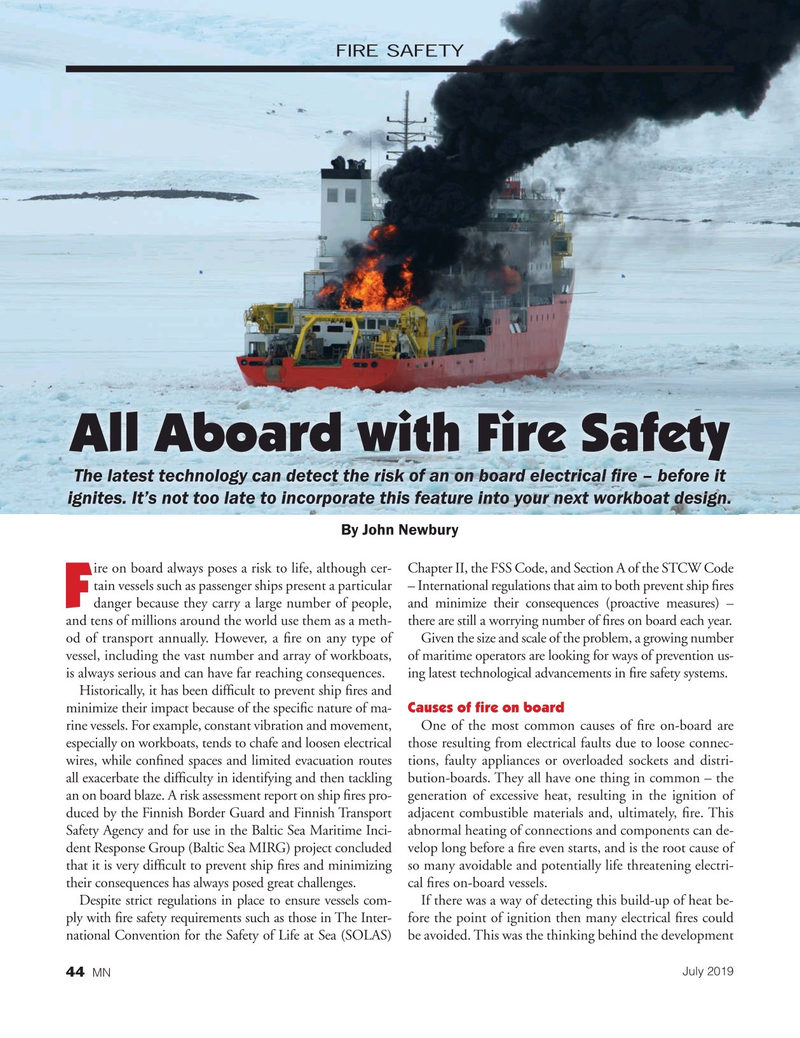
Page 44: of Marine News Magazine (July 2019)
Propulsion Technology
Read this page in Pdf, Flash or Html5 edition of July 2019 Marine News Magazine
FIRE SAFETY
All Aboard with Fire Safety
The latest technology can detect the risk of an on board electrical ? re – before it ignites. It’s not too late to incorporate this feature into your next workboat design.
By John Newbury ire on board always poses a risk to life, although cer- Chapter II, the FSS Code, and Section A of the STCW Code tain vessels such as passenger ships present a particular – International regulations that aim to both prevent ship ? res
F danger because they carry a large number of people, and minimize their consequences (proactive measures) – and tens of millions around the world use them as a meth- there are still a worrying number of ? res on board each year. od of transport annually. However, a ? re on any type of Given the size and scale of the problem, a growing number vessel, including the vast number and array of workboats, of maritime operators are looking for ways of prevention us- is always serious and can have far reaching consequences. ing latest technological advancements in ? re safety systems.
Historically, it has been dif? cult to prevent ship ? res and minimize their impact because of the speci? c nature of ma- Causes of fire on board rine vessels. For example, constant vibration and movement, One of the most common causes of ? re on-board are especially on workboats, tends to chafe and loosen electrical those resulting from electrical faults due to loose connec- wires, while con? ned spaces and limited evacuation routes tions, faulty appliances or overloaded sockets and distri- all exacerbate the dif? culty in identifying and then tackling bution-boards. They all have one thing in common – the an on board blaze. A risk assessment report on ship ? res pro- generation of excessive heat, resulting in the ignition of duced by the Finnish Border Guard and Finnish Transport adjacent combustible materials and, ultimately, ? re. This
Safety Agency and for use in the Baltic Sea Maritime Inci- abnormal heating of connections and components can de- dent Response Group (Baltic Sea MIRG) project concluded velop long before a ? re even starts, and is the root cause of that it is very dif? cult to prevent ship ? res and minimizing so many avoidable and potentially life threatening electri- their consequences has always posed great challenges. cal ? res on-board vessels.
Despite strict regulations in place to ensure vessels com- If there was a way of detecting this build-up of heat be- ply with ? re safety requirements such as those in The Inter- fore the point of ignition then many electrical ? res could national Convention for the Safety of Life at Sea (SOLAS) be avoided. This was the thinking behind the development
July 2019 44 MN
MN July19 Layout 32-49.indd 44 6/20/2019 2:15:35 PM

 43
43

 45
45
